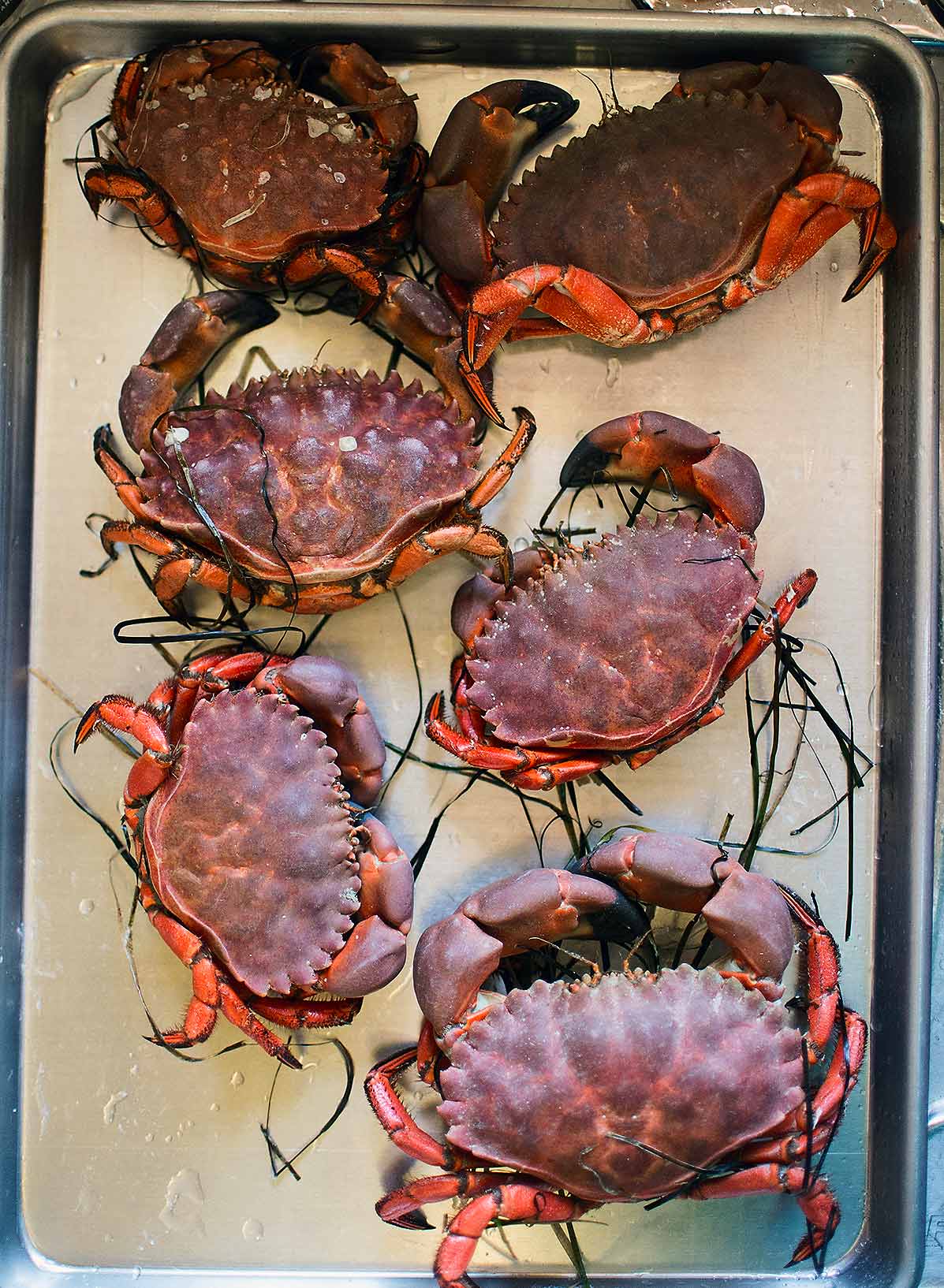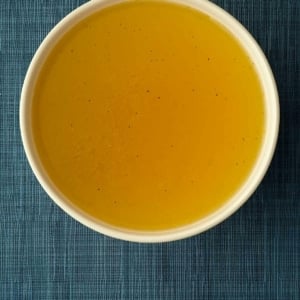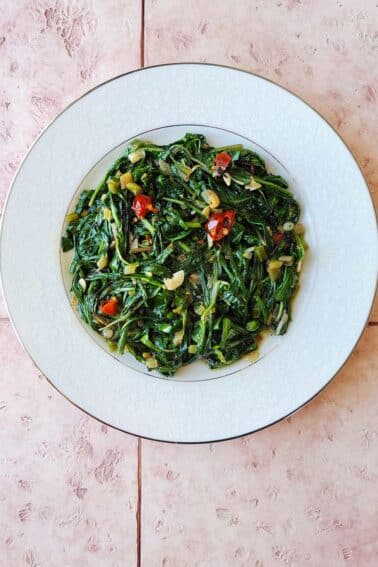As an Amazon Associate I earn from qualifying purchases.
Seafood stock, usually crab stock for me, is a mainstay in my kitchen during Dungeness crab season, which in California runs from November through June. But a good seafood stock can be made with any sort of crab, or lobsters, crawfish, shrimp, or fish.
Really what makes a nice seafood stock is a mix of seafood, a grab bag of shells and bones you might otherwise throw away.

I like to gather the shells and such as I eat seafood, then freeze them in bags until I want to make a seafood stock. I find that the best bits are the shells from the legs, as well as the top shell. If you use the inner shell bits from the body, there’s a lot of fat in there that can cloud the stock. If you aren’t worried about that, go right ahead.
Shrimp heads and shells are also great, and you might want to toss in a fish head or backbone for good measure. Play with it.
Unlike my recipe for fish stock or for a straight-up shrimp stock, I use tomato in seafood stock. The reason is because tomato and shellfish like crabs, crawfish and lobsters just go so well together. It’s only a couple tablespoons of tomato paste, but it makes a difference.
I love adding chopped fresh fennel bulb because it adds a hint of anise flavor without being overpowering. My other touch is a bit of mushrooms, for added savoriness. I prefer dried porcini, but matsutake are great, and hell, plain button mushrooms are fine.
Other than that, I use your typical mirepoix of carrot, celery and onion.

This recipe makes a reasonably clear seafood stock, but if you want a crystal clear seafood stock, the easiest thing to do is freeze it, then let it thaw through a regular coffee filter, which will filter out the fine particulates that are clouding the stock. It takes a few hours, and you can do it at room temperature, or in the fridge overnight.
Another tip for a clearer stock is to never let it boil. Boiling will cloud a stock worse than most other stocks; not sure why that is.
Obviously you can make a seafood stock out of any crab, lobster or shrimp. I’ve done it with pretty much every species in North America, including the shells from snow and king crab legs.
Use this stock in seafood soups and stews, as a base for a French crab sauce like Nantua (normally made with crayfish), or Crab Risotto or in Crab Curry. Or as the base for any fish or seafood stew, such as this East African inspired fish stew.
Once made, seafood stock will keep in the fridge about a week, tops, and it freezes well for about 6 months. After that it gets fishy.
Seafood Stock
Ingredients
- 1 to 2 pounds crab, lobster or shrimp shells
- 4 tablespoons olive oil
- 1 large onion, chopped
- 2 garlic cloves, chopped
- 3 celery stalks, chopped
- 2 carrots, chopped
- Tops from 1 fennel bulb chopped
- 1/2 pound mushrooms, or a handful of dried, chopped
- 2 tablespoons tomato paste
- 1 cup white wine
- 3 bay leaves
- 2 tablespoons black peppercorns, cracked
- 1/2 cup chopped parsley
- Salt
Instructions
- Heat the olive oil in a large stockpot and sauté the vegetables over high heat for 5 minutes, stirring often, until the onions are translucent. If you are using fresh mushrooms, add them, too. Add the tomato paste, stir well and cook over medium heat for another 2 or 3 minutes, until it darkens.
- Add the shells and bodies and bones and smash them all with a potato masher. If you are using dried mushrooms, add them here. Mix well to coat with the tomato paste and to disperse everything. Cook for another 2 to 3 minutes, stirring a couple times.
- Add the white wine, bay leaves, peppercorns and parsley and bring to a boil. Let this cook for a minute or two, then pour in enough cold water to cover everything by about an inch; normally this is about 10 cups. Let this simmer very gently for between 30 and 45 minutes. Add salt to taste.
- Turn off the heat. Set up another large pot or bowl and put a fine-meshed strainer over it. Line the strainer with a plain paper towel or cheesecloth and ladle the stock through this set-up into the large pot or bowls. Do not try to get the last dregs of stock, as this will be full of debris. Discard the shells, etc.
- Let the stock cool for 15 to 30 minutes, then use or pour into quart jars. The stock will keep for a week in the fridge. It will freeze well for 6 months, but after that it deteriorates rapidly.
Notes
Keys to Success
- Don’t let this boil (you want a very gentle simmer) and don’t be tempted to simmer it for more than 1 hour or it will lose flavor and get cloudy.
- Really wail on the shells, etc. when they go into the pan. You want the pieces small, which will give you better flavor faster. You can put them in a bag and crush them before they go into the pot, too.
- All fish and seafood stocks are best immediately, so do yourself a favor and have something that will use them in mind when you start. I really love crab risotto or shrimp risotto made with fresh stock.
Nutrition
Nutrition information is automatically calculated, so should only be used as an approximation.





I just made this stock with blue crab legs and other pieces I did not want to pick out. It is amazing. I love things hot so I added two of my fresh thai peppers.
I recently prepared this dish again and almost have the recipe memorized! What’s remarkable is the positive reception it receives when cooked indoors, unlike the aftermath of steaming crab or shrimp, which can linger. I attribute this to the wonderful aroma of the fennel bulb. Perhaps I should incorporate fennel into our next crab boil!!
Thank you, Hank, for consistently delivering outstanding recipes!
Hi Hank,
I made this stock (using your cookbook) with lobster shells today. Tastes great!
You link the crab curry as a potential dish to make with this stock but it looks like the curry uses coconut milk instead of stock. Did I miss it? Can I substitute the stock for the coconut milk? Thanks!
Instead of freezing can you water bath the stock?
Katie: No. You cannot water bath can stock. You can pressure can it, however.
Katie: No, you can’t water bath can stock. You can pressure can it, though.
Do you simmer with the stockpot covered or uncovered?
I can’t wait to make this!
Jimmy: Uncovered.
I like the recipe and look forward to trying it. Couldn’t find how much water to use. 5 Quarts? Enough to cover the ingredients about an inch? Inch and a half?
Alan: Yep, Enough to cover the ingredients by about an inch.
I plan on using lobster and shrimp shells for this. Do I need to rinse them before I make the stock? I’m especially concerned about all the “stuff” inside the lobster bodies. Thanks
Kitten: I do typically rinse the insides, yes.